Menu
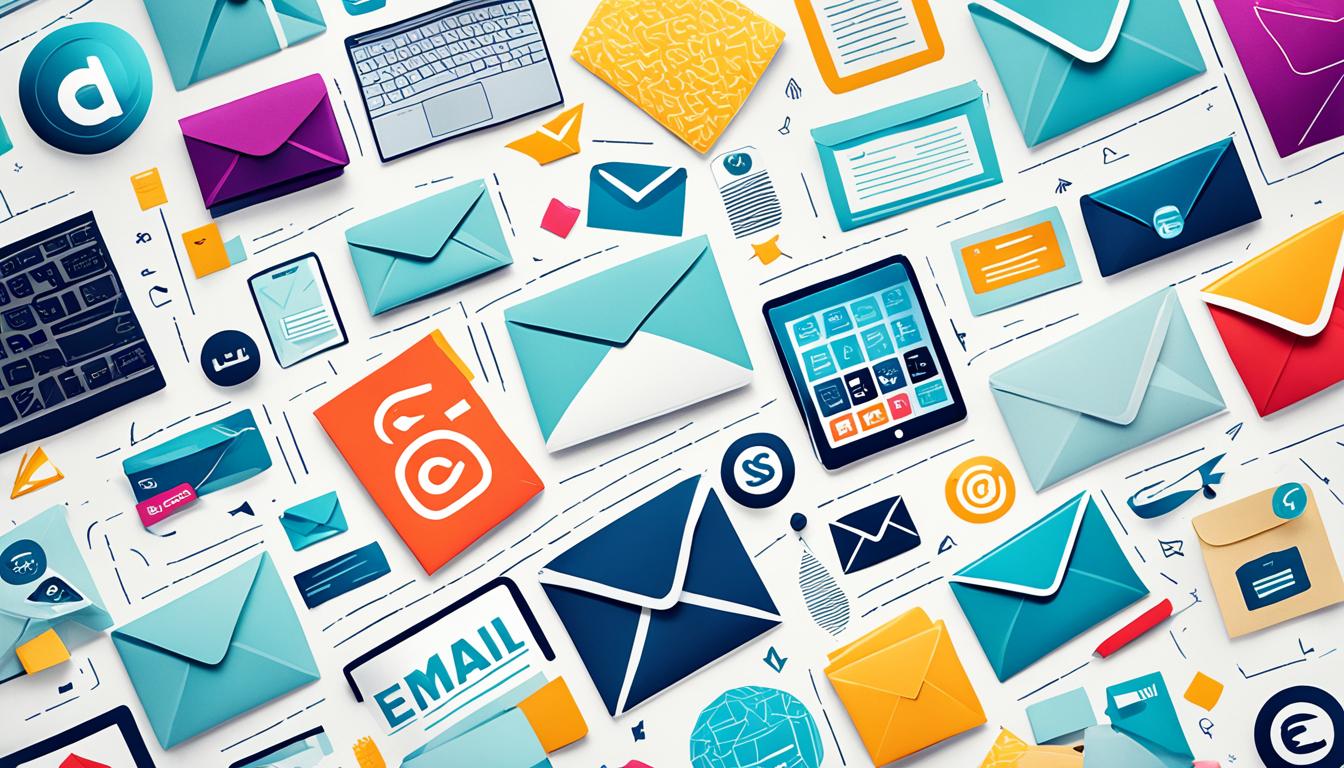
Did you know that nearly 70% of online shopping carts get left behind? This big number from Shopify shows how much money is lost. By using email marketing, businesses can change these lost sales into real ones. They do this by sending out emails that are special and meant just for each customer.
old customers are really important because they are likely to buy again. But there’s also the power of email to attract new customers. Believe it or not, businesses can make a lot of money, up to 40%, from these special emails. That’s more than what they get from normal ads.
To make emails work even better, companies can use cool tricks. Like sending birthday wishes or saying when something a customer liked is back in stock. This makes the shopping experience more personal. And it encourages people to buy with clear messages like ‘Checkout now.’
Email marketing is key in e-commerce, engaging customers with personalised messages. It offers high ROI. Businesses see better results in marketing and conversion with this tool.
Email marketing excels in making customer interactions personal. It uses audience segmentation to send content matching specific preferences. Studies show a 760% revenue boost from this. It not just attracts buyers but also fosters their loyalty.
It lets e-commerce businesses communicate with shoppers in different stages of buying. Welcome emails, with a 50% open rate, and abandoned cart emails, saving 29% lost sales, are prime examples. It also means community building through newsletters, engaging and retaining customers.
Email marketing is low cost and brings big returns. For every $1 spent, $35 to $40 can come back. Targeted emails alone drive 58% of revenue and show their power in boosting sales. In some areas, it scores an impressive ROI of 42:1.
Businesses can learn a lot from customer interactions via email. They gather data from open, click, and conversion rates, aiming to improve adverts. With Google’s new policy from February 1, 2024, maintaining a clean email list is critical.
Linking email marketing with other online tools boosts its influence. It maintains a unified message while expanding promotion and retargeting options. This unity strengthens its role in e-commerce strategies.
Email marketing is key for online sellers, with many email types available. These include promotions, updates on orders, and messages throughout a customer’s journey. By recognising these differences, you can boost your selling power and keep customers interested online.
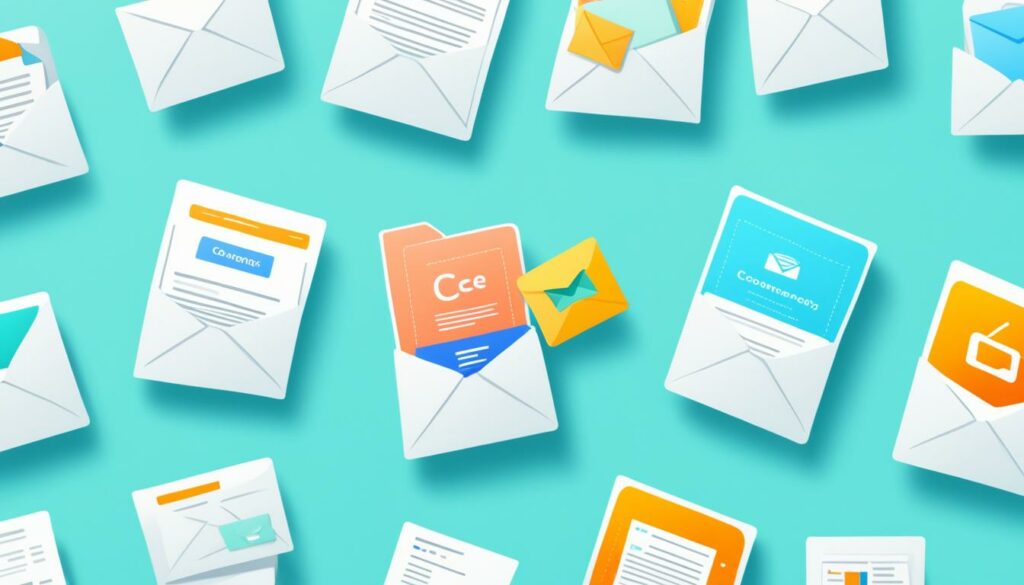
Promotional emails jump into action, offering deals or new items. They push for quick buys and keep customers engaged. PUMA, for example, uses this to offer birthday discounts, boosting loyalty. These campaigns can be super profitable, earning $36 for every $1 spent.
Transactional emails share key details about customer purchases. This includes order confirmations and shipping updates. Nike, for instance, keeps customers informed with their order dispatch emails. These types of emails are opened a lot because they provide needed, timely info.
These emails are like personal guides for customers, offering help at every step. From the first welcome email to those that bring back old customers, they’re key. Welcome emails shine with a 50% open rate, while reminders about abandoned shopping carts can save a quarter of them. Such emails are vital for long-term customer loyalty and winning back those who’ve strayed.
The variety of emails in e-commerce shows that a mix is best. Whether promoting, updating orders, or guiding customers along their journey, each type has a significant role. This diversity is what makes e-commerce email strategies powerful.
An email marketing strategy is key to a successful digital campaign. It’s important to set clear goals for each step. This helps make your campaigns meaningful.
Key to any email marketing strategy are goals you can measure. You should aim to boost sales, reduce abandoned carts, and improve click-through rates. Also, getting feedback from subscribers early is important. This will focus your actions towards specific aims, making your campaigns more effective.
Audience segmentation is vital for personalising your emails. By splitting your audience into groups based on their actions, who they are, and what they’ve bought, you can send each group material suited to their interests. Recent studies show that this can lead to higher open and click rates. It’s a proven way to get people more involved with your brand.
Great content grabs your audience’s attention. It starts with catchy subject lines. Make your emails valuable and true to your brand, using a range of media. Include phrases like ‘Shop Now’ or ‘Learn More’ to encourage action. Good content not only engages but also keeps customers coming back.
To sum up, a solid email marketing plan with clear goals, audience segmentation, and engaging content can make a big difference. Follow these steps carefully for better responses and more sales from your digital efforts.
Email marketing boosts sales with solid ROI numbers, proving its worth. To boost ROI, focus on personalisation and pick the best times to send emails.
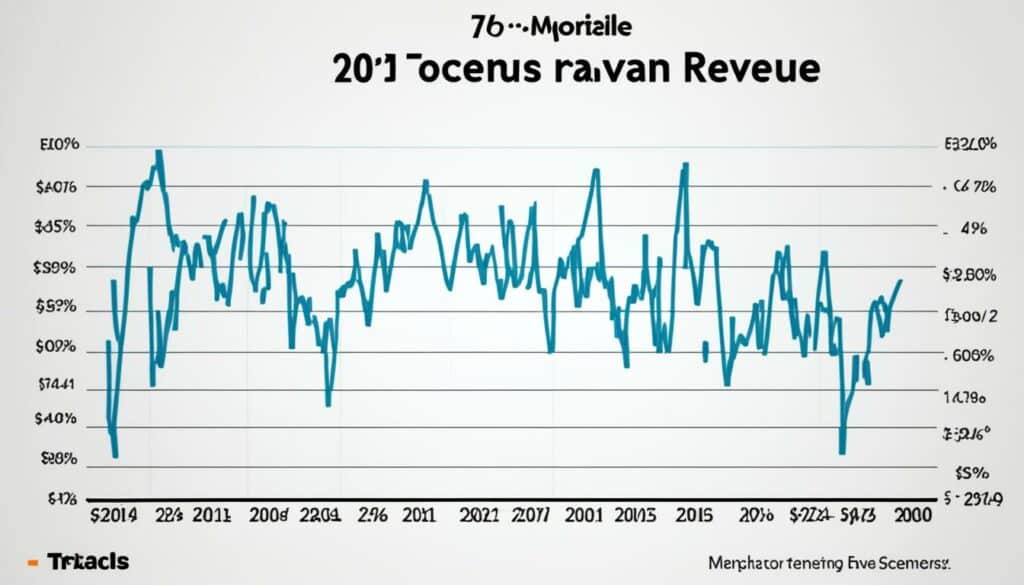
To get the most from email marketing, personalisation is key. Make offers and content fit each customer’s likes and actions. This way, every email feels just right for the reader.
If you use what a person’s bought before to suggest new items, or give them birthday deals, you can get more people to engage. Sharing personal stories can also draw readers in, making them more loyal.
When you track what works with email marketing software, you can send out very tailored messages. This not only gets more people to open and click the emails but helps your team decide when to keep going or to stop certain campaigns.
Figuring out the best times to send emails is crucial. Being aware of when your audience checks their emails most helps a lot. Most emails are read on phones, so pick times when mobile use is high.
A/B testing send times can help you find the perfect moments to reach out. By using customer feedback, you can refine your approach. This keeps your subscribers engaging more with what you send.
For instance, making $12,000 from a $200 email campaign shows how effective this can be. Your ROI, in this case, would be 59 times what you put in. Fine-tuning your strategy and timing can lead to these impressive results.
Using personalisation and finding the right send times can really pay off in your email marketing. These steps help make your investment worthwhile.
Building an email list is key for online shops aiming to use email marketing well. Start by making eye-catching ways for people to sign up on your site. You can use fun pop-ups or simple ones shown to work well. Don’t forget to include a gift, like an eBook or a special discount. These things make people more likely to sign up.
Using social media like Facebook and Twitter can help a lot too. Both have millions of users. You can ask people to sign up with interesting posts or by hosting live events. Webinars are great for getting sales and more email addresses at the same time.
Getting people to refer others can quickly grow your list too. You can reward current subscribers for bringing in new ones. Doing promotions with others in your field can help as well. Promote these joint efforts everywhere to reach more people.
It’s really important to know who your audience is from the beginning. Tailored emails are much more effective than general ones. A lot of marketers see great returns through email. This shows that successful campaigns come from having a good and fit list.
Be open and honest about what signing up means for your readers. This earns their trust and makes them more likely to stay. That leads to strong, ongoing connections and better results from your marketing.
Telling people exactly what you’d like them to do is crucial too. Making CTAs personal makes a big difference in how many people sign up. Knowing that many check their emails several times a day, make sure yours stand out.
Email automation changes how online shops connect with their customers. It saves time by doing many marketing tasks on its own. This lets marketers put more effort into planning and being creative. By sending out emails that are just right, customers stick around more. Now, let’s look at some important automatic emails and how they help online shops.
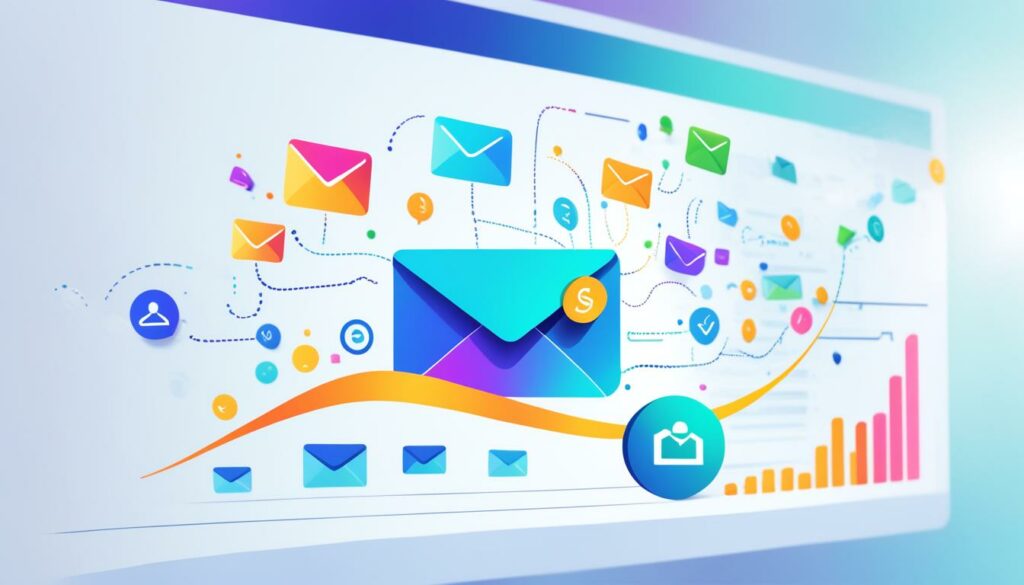
Having a great welcome email series is key. It makes a brilliant first impression on new sign-ups. These emails show what the brand is about and invite the new member in. Using their name or pointing out items they might like makes people more involved. This steady series helps the brand and keeps customers coming back.
Many shops face the same problem: carts left behind. A strategy for this includes a series of emails. It starts with a gentle reminder. Then adds an offer like a discount. It ends with an email that says the deal won’t last long. These emails try to win back lost sales. They show how powerful email automation is at boosting sales.
Getting inactive subscribers back is important. These emails say they were missed and often offer deals. They may also update on new items. The key is to understand what they like and show them. This can make them interested again. Good re-engagement can improve loyalty. It’s a top way to keep your customers caring about your shop.
Email automation makes marketing smoother for online shops. It boosts how much customers interact and sales. Welcome emails, dealing with abandoned carts, and re-engagement are vital parts of this.
Email marketing is great for online shops. It helps create loyal customers and makes more e-commerce sales. By using targeted sales methods and checking and changing email campaigns, you can lift your sales and overall revenue.
Email marketing can boost e-commerce sales in many ways. You can send new product alerts, special discount codes, and recommend related items. Also, order and subscription confirmation emails often get opened a lot. You can use these to show off more products or deals.
Another smart move is sending lifecycle emails when customers do something. These could be welcome messages, emails to win back lost customers, or to remind them to buy again. Replenishment emails, which remind customers to buy again, are very effective. They have a 53.6% click rate. Also, giving people first dibs on new products makes them feel special. This often leads to more immediate sales.
To really boost sales, keep customers engaged. Consider giving them rewards for feedback. Also, sending them useful content that’s not just about selling can make them stay loyal. This can lead to repeat business.
Keep an eye on your strategies and adjust your email plans using what you learn. Try A/B testing to see what emails work best. This helps you figure out what your audience likes most in terms of email subject, content, and design.
Check your email’s metrics often. Look at factors like how many emails get opened, how often people click through, and how many people buy. This feedback is key for making changes in real time. This might mean adjusting how often you send emails or changing your message to better suit your customer’s needs.
It’s important to avoid common email mistakes, like using words that get caught in spam filters. Also, be sure not to send too many emails and tire your subscribers out. By being flexible and reacting to the feedback, you can make your email marketing better and keep growing.
In the end, using these strategies and regularly checking and refining your email campaigns is vital for boosting e-commerce sales. This mix of email marketing tactics doesn’t just improve sales performance. It also makes customers more loyal, leading to steady growth.
Using personalisation in email marketing can boost conversion rates. Tailoring content to match recipients’ interests is key. This creates a stronger bond that leads to improved loyalty and more repeat purchases.
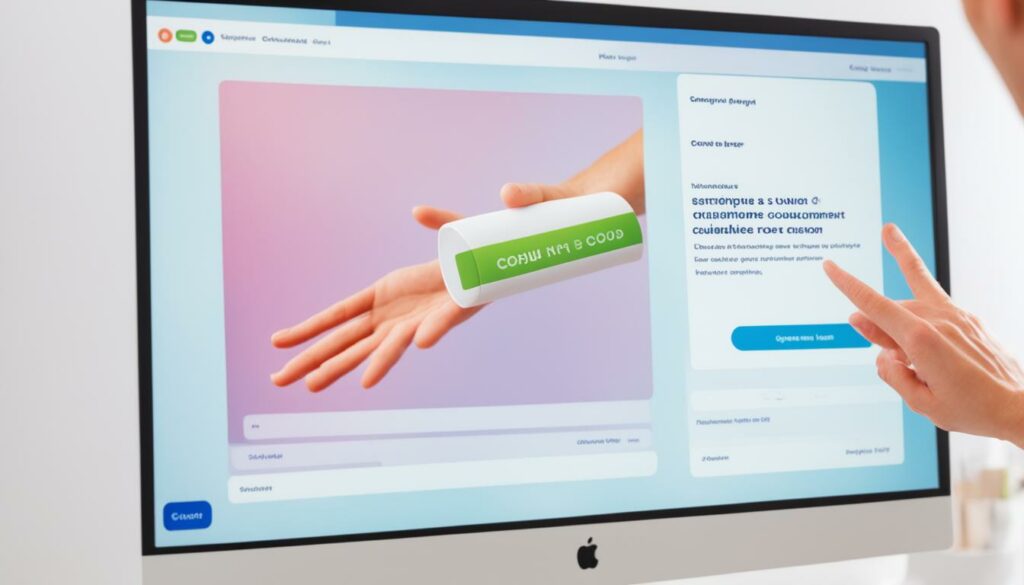
Analysing how customers behave is critical for good marketing. By looking at what they’ve bought before and how they’ve engaged, we can send the right content at the best time. For example, suggesting products based on past buys can make the emails more relevant. This increases the chance of a sale.
Grouping customers by age, gender, and where they live improves how we talk to them. This way, we can tailor our messages to what different groups like or need. A campaign for young city-dwellers might push the latest urban trends, while one for older people in the suburbs might highlight family products. Matching content to demographic details makes our emails more effective and engaging.
Combining demographic and behavioural cues makes marketing more insightful. This ensures our messages hit closer to home for the reader. In turn, this boosts sales and strengthens the bond between the brand and its customers. Personalisation is a powerful tool in creating enjoyable and effective marketing.
Conversion rates help us even more. At the start of 2021, the global rate was under 2%, but dropped to 1.5% in February 2022. However, different areas see different results:
Continuous tracking and strategy adjustment are necessary based on these insights. An 80% average for email campaigns’ deliverability is great news. But, the 0.5% unsubscribe rate reminds us to work hard to keep our subscriber list healthy. With the power of marketing analytics, we can offer more tailored content. This leads to better sales and happier customers.
Here’s a look at how different industries in eCommerce are doing in terms of conversion rates:
| Industry | Conversion Rate (%) |
|---|---|
| Arts and Crafts | 4.17 |
| Kitchen and Home Appliances | 2.64 |
| Health and Wellbeing | 2.11 |
| Toys, Games, and Collectibles | 1.98 |
| Food and Drink | 1.51 |
| Electrical and Commercial Equipment | 1.47 |
| Fashion Clothing and Accessories | 1.37 |
| Sports and Recreation | 1.36 |
A/B testing in emails helps refine how well emails perform. Marketers try different things like subject lines and content types. This way, they find what their readers like best. This improves how many people engage with the emails and take actions.
Testing subject lines is a big part of A/B testing. One study found that the best email subject line length is between 61-70 characters. Also, using the subscriber’s name can make open rates go up by more than 14%. With people’s attention span being so short, the first words in an email must capture interest quickly.
Testing content types in emails is important too. People process pictures much faster than words, about 60,000 times faster. So, adding impressive images to emails is key. Personalising emails and using clear call-to-action buttons are also important. They can boost action rates significantly.

| Test Element | Variation A | Variation B | Result |
|---|---|---|---|
| Subject Line | “Exclusive Offer Just for You” | “[Name], Don’t Miss Out on This Deal!” | 14% Higher Open Rate for Variation B |
| Call-to-Action | Text Link “Shop Now” | Button “Shop Now” | 27% Increase in Click-Through Rate for Button |
| Content Layout | Text-heavy with Minimal Images | Visual-heavy with Concise Text | 20% Higher Engagement for Visual-heavy Layout |
Using A/B testing, brands keep making their email marketing better. This way, they improve not just subject lines and content but their whole email strategy. They can send out emails that more people like and are effective.
Combining email, social media, and content marketing can boost the power of your online sales efforts. Doing so creates a smooth, engaging experience for customers wherever they interact with your brand. This makes it easier to draw them in.
Sharing your email content on social media broadens its reach and impact. For instance, Jeep mixes email marketing with ads on social platforms to connect better with people. This approach increases brand visibility and brings more visitors to your site.
Linking email campaigns with your content efforts enhances both. Honda pairs email marketing with quality content, building deeper ties with their audience. It becomes a powerful way to share brand stories, messages, and helpful info.
Taking a well-thought-out approach to join these marketing channels could open new doors. With careful planning and regular check-ups, a company can greatly improve its marketing impact.
| Brand | Approach | Outcome |
|---|---|---|
| Jeep | Social media cross-promotion with email marketing | Enhanced audience engagement |
| Honda | Integrating content marketing with email campaigns | Higher open and click-through rates |
Avoiding email marketing pitfalls is key for e-commerce success. One common mistake is using too much sales talk in emails. This might cause emails to be marked as spam. Instead, focus on giving emails value, not just promotions. Also, over half of all emails are opened on phones. So, it’s vital to make emails work well on mobiles. Not doing so can really hurt your eCommerce efforts.
Sending emails that aren’t right for the person or sending them too often can tire your subscribers out. This can make them opt out of your emails. To keep this from happening, it’s important to divide your email list. This can make it more likely that your emails will be seen, read, and acted upon. And, finding the right balance in how often you send emails is crucial. Send too many, and you could lose subscribers; send too few, and you might miss on sales, especially for quick-selling items.

Not making emails personal enough is a big mistake, too. Personalised emails mean more to your recipients. They are likely to engage more with these emails. But many marketers miss this, sending emails that seem generic. Also, it’s a must to check how your emails look on different devices and with various email services. This helps avoid display problems that could make your campaign less effective.
So, here’s a quick look at the key email marketing pitfalls and how to avoid them:
Knowing these common mistakes and dealing with them early is critical. It helps keep your email list strong and your marketing successful. By working on these areas, you can make your email marketing more effective. This way, you can deal better with the usual eCommerce challenges.
Successful email campaigns in e-commerce are all about smart planning and clear messages. I’ll show you two stories, one about winning back missed sales and the other a big launch.
When people leave things in their online cart, most shops lose 70% of these sales. Beardbrand, a personal care brand, stands out here. They know many shoppers change their minds over high shipping charges. So, they offer discounts in their reminder emails. This wins back 54% of would-be customers.
This strategy works wonders. Their emails get a 45% open rate and 21% of people click through. Half of these clicks lead to a purchase. This means turning lost sales into real money.
Launching new items often involves big email pushes. One standout is Harry’s, a grooming brand for men. They offered sneak peeks and early deals to their subscribers. This built up excitement and got people talking. As a result, three quarters of shoppers make choices based on what friends say.
This push was not just about the ‘new’ factor. It was also highly targeted. Three out of four marketers agree: personalised campaigns boost sales. The combo of good communication and making customers feel special led to a big increase in sales at launch.
| Campaign Aspect | Abandoned Cart Recovery | Product Launch Announcement |
|---|---|---|
| Key Objective | Recover lost sales | Maximise initial sales |
| Key Tactic | Addressing objections like high shipping costs | Offering exclusive previews and early access |
| Performance Indicators | 45% open rate, 21% click-through rate, 50% conversion on clicks | Increased initial sales through targeted personalization |
These stories show how careful planning and appealing messaging make emails work. Whether we want to win back lost sales or make a big splash, the key is in the details. The success of these campaigns underlines the power of offering what your customers really need and want.
Email marketing is key for online shops, bringing back $35 to $40 for every dollar you spend. This makes the return on investment huge, at 4,400%. It beats other ways, like social media, easily. This high potential makes email marketing very cost-efficient for online stores. Plus, it’s easy to check how well your email ads are doing by looking at open, click-through, and conversion rates.
Keeping your email list healthy is super important too. To avoid getting blocked by Google and others after February 1, 2024, spam rates must be under 0.3%. By using behaviour tracking and audience segments, shops can send emails that feel personal. This wins customer loyalty and more sales. Regularly sending custom deals, product tips, and rewards makes customer services better in a big way.
But emails do more than sell. They also build a community and gather feedback. This makes subscribers feel like they’re a part of something special. Tailored emails not only help sell more but also make stronger bonds with customers. Lastly, mixing email marketing with other online tools in a smart way can help keep customers for a long time. It also makes your marketing campaigns even more powerful.
Email marketing boosts e-commerce sales by targeting potential customers. It uses data to find who is likely to buy again. New customer emails help them make their first purchase.
Personalised emails are crucial for engaging customers. They make your emails fit each person better. This makes the customer feel understood and keeps them coming back.
Email marketing is cheap and gives great returns. It can bring back £35 to £40 for every £1 spent. This is because it encourages people to shop more than once.
There are several types of e-commerce emails:- Promotional emails are for sales or new items.- Transactional emails provide essential info.- Lifecycle emails are based on what a customer has done, encouraging more purchases.
To start an effective email marketing plan, set clear and measureable goals. Understand your audience’s behaviour, demographics, and what they’ve bought. Make email content that people really want to read.
To make the most from email marketing, try these tips:- Personalise emails.- Send emails at the best times.- Use a mix of text, images, and videos.- Reward loyal customers.- Change content based on how people interact.
To grow your email list, offer good reasons for people to sign up. For example, you can give away free eBooks or discounts. Be honest and clear why subscribing is good for them.
Email automation makes your marketing more efficient and personal. It does tasks like welcoming new subscribers or reminding people about items in their cart. This keeps your audience engaged without constant work.
To sell more, try sending:- Replenishment emails for items people might need again.- Asking for feedback and rewarding it.- Giving early looks at new products.By watching how your emails do, you can make them work better.
Know your customers’ actions and who they are. Then, use this info to make emails they’ll really like. This personal touch makes people more likely to buy from you.
To check how well your emails do, look at open and click rates. Also, see how many people buy because of your emails. This tells you what’s working and what’s not.
A/B testing helps by showing what gets people to open and read your emails. It lets you try out different ways to see what people like. This way, you can always make your emails better.
Mix email marketing with social media and content marketing for a bigger reach. These efforts together strengthen your brand message. Each channel works with the others to bring in more customers.
Stay away from sales-heavy or spammy emails. Also, don’t send too many. Make sure your emails are personal. Avoiding these mistakes keeps your customers interested and your emails effective.
Good e-commerce emails include:- Emailing people who left things in their cart, to remind them to buy.- Announcing new products, giving early access and creating excitement.These strategies show how careful planning and creative ideas can lead to success.